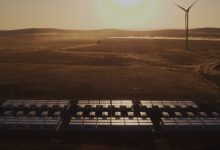Danish energy giant Copenhagen Infrastructure Partners has formally unveiled its plans for what would be the biggest battery storage project in South Australia, and the first of a major push into energy storage projects across the country.
CIP is best known in Australia for its part ownership of the 2.2 GW Star of the South project in Victoria, widely regarded as the most advanced offshore wind project in the country, but it is now also turning its attention to battery storage.
On Wednesday, CIP announced it had chosen Canadian Solar’s e-storage division and its Solbank technology to build its first battery project, a 240 MW, two hour (480MWh) battery at Summerfield in South Australia. A final investment decision is due next year, with construction to begin by 2025.
South Australia is the world leader in wind and solar, with the variable technologies providing more than 71.5 per cent of local demand over the past 12 months, and expects to reach “net” 100 per cent renewables within a few years.
However, CIP says Summerfield is the first of multiple large-scale battery projects planned for Australia, and part of its global $100 billion development pipeline across offshore and onshore wind, renewable hydrogen, pumped hydro and battery storage.
CIP Australia head Jørn Hammer called the Summerfield battery an “easy win” in terms of transmission infrastructure, and says it will be a catalyst for investment needed to unlock more generation in the South East Renewable Energy Zone.
CIP is believed to be looking at up to 2GW of battery storage in Australia, mostly around two hours of storage, with two projects targeted in each of the state grids that make up the National Electricity Market.
CIP joins a host of international players looking at battery storage in Australia, including Brookfield, BlackRock’s Akaysha Energy, Macquarie’s Eku Energy, along with established energy giants Neoen, Iberdrola and Engie.
The Summerfield project comes with a backstory that says a lot about the energy transition, as the site near Tepko, east of Adelaide, was supposed to host a 300 MW gas power plant with a small 12 MW solar farm backup and 30 MW battery.
But shifting sentiments around emissions and the rapidly falling cost of battery storage has pushed fossil fuel generation out of the picture – it simply can’t compete anymore with renewables and batteries.
CIP says the Summerfield battery will have two hours of storage, which can be expanded depending on market need, and is located on the proposed 275kV South East transmission line expansion which will bring in new renewable generation from the South East Renewable Energy Zone.
“South Australia was a pioneer in bringing grid-scale batteries into the electricity system, creating a template taken up around the world,” says South Australia energy and mining minister Tom Koutsantonis, referencing the world’s first big battery, the Hornsdale Power Reserve.
“We are now at the forefront of the next phase, in which batteries provide stabilisation services and make a significant market impact by charging up from excess renewables and discharging energy when the sun isn’t shining and the wind isn’t blowing.”
South Australia streamlines future renewables
Last week, South Australia passed legislation intended to cut red tape for renewable energy and green hydrogen projects.
Its Hydrogen and Renewable Energy Bill consists of six Acts merged into one and creates five licences for each of the key stages of project development – from early research and feasibility right through construction, operation, and closure.
The new bill applies to both freehold and government-owned land and state waters.
Those looking to develop renewable or hydrogen projects on freehold land will need to secure access through direct agreement with landowners, and a new competitive system will be introduced for conferring access and licenses for projects on pastoral land and state waters.
See also RenewEconomy’s Big Battery Storage Map of Australia
And: Liddell to host giant battery after AGL and Akaysha win Australia’s biggest capacity tender










